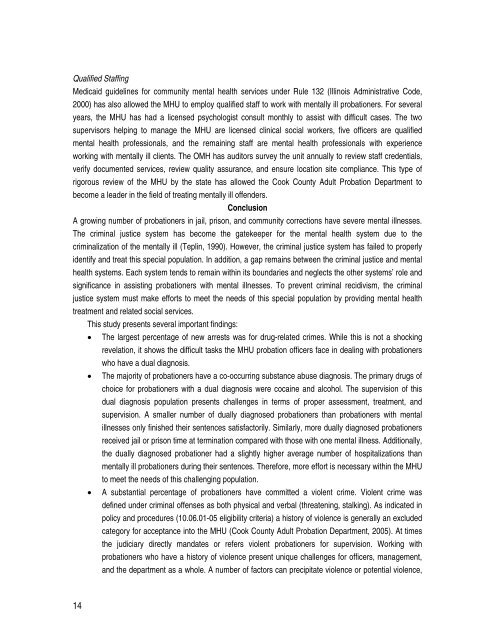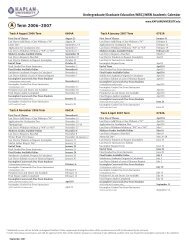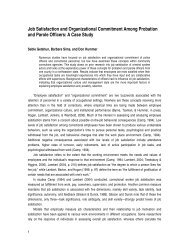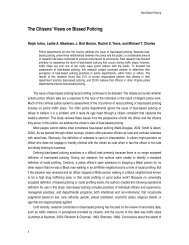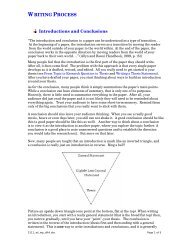Adult Probation Department Mental Health Unit: An Outcomes ...
Adult Probation Department Mental Health Unit: An Outcomes ...
Adult Probation Department Mental Health Unit: An Outcomes ...
- No tags were found...
You also want an ePaper? Increase the reach of your titles
YUMPU automatically turns print PDFs into web optimized ePapers that Google loves.
Qualified StaffingMedicaid guidelines for community mental health services under Rule 132 (Illinois Administrative Code,2000) has also allowed the MHU to employ qualified staff to work with mentally ill probationers. For severalyears, the MHU has had a licensed psychologist consult monthly to assist with difficult cases. The twosupervisors helping to manage the MHU are licensed clinical social workers, five officers are qualifiedmental health professionals, and the remaining staff are mental health professionals with experienceworking with mentally ill clients. The OMH has auditors survey the unit annually to review staff credentials,verify documented services, review quality assurance, and ensure location site compliance. This type ofrigorous review of the MHU by the state has allowed the Cook County <strong>Adult</strong> <strong>Probation</strong> <strong>Department</strong> tobecome a leader in the field of treating mentally ill offenders.ConclusionA growing number of probationers in jail, prison, and community corrections have severe mental illnesses.The criminal justice system has become the gatekeeper for the mental health system due to thecriminalization of the mentally ill (Teplin, 1990). However, the criminal justice system has failed to properlyidentify and treat this special population. In addition, a gap remains between the criminal justice and mentalhealth systems. Each system tends to remain within its boundaries and neglects the other systems’ role andsignificance in assisting probationers with mental illnesses. To prevent criminal recidivism, the criminaljustice system must make efforts to meet the needs of this special population by providing mental healthtreatment and related social services.This study presents several important findings:• The largest percentage of new arrests was for drug-related crimes. While this is not a shockingrevelation, it shows the difficult tasks the MHU probation officers face in dealing with probationerswho have a dual diagnosis.• The majority of probationers have a co-occurring substance abuse diagnosis. The primary drugs ofchoice for probationers with a dual diagnosis were cocaine and alcohol. The supervision of thisdual diagnosis population presents challenges in terms of proper assessment, treatment, andsupervision. A smaller number of dually diagnosed probationers than probationers with mentalillnesses only finished their sentences satisfactorily. Similarly, more dually diagnosed probationersreceived jail or prison time at termination compared with those with one mental illness. Additionally,the dually diagnosed probationer had a slightly higher average number of hospitalizations thanmentally ill probationers during their sentences. Therefore, more effort is necessary within the MHUto meet the needs of this challenging population.• A substantial percentage of probationers have committed a violent crime. Violent crime wasdefined under criminal offenses as both physical and verbal (threatening, stalking). As indicated inpolicy and procedures (10.06.01-05 eligibility criteria) a history of violence is generally an excludedcategory for acceptance into the MHU (Cook County <strong>Adult</strong> <strong>Probation</strong> <strong>Department</strong>, 2005). At timesthe judiciary directly mandates or refers violent probationers for supervision. Working withprobationers who have a history of violence present unique challenges for officers, management,and the department as a whole. A number of factors can precipitate violence or potential violence,14


